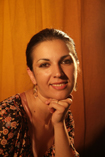by Guytano Parks
Variations
The Sonata, K. 331 in A major is Mozart’s only piano sonata which utilizes a theme with variations rather than the standard Sonata Allegro form for its first movement. Friscioni played it with lovely tone and a fine sense of classical style and proportions. In the opening Andante grazioso (performed without repeats), Friscioni’s cantabile approach allowed the music to breathe, her phrasing leaving plenty of room for details of articulation and dynamics. The six variations which followed, all in A major except for the third which is in minor, unfolded beautifully. Running scale passages, accidentals, repeated staccato notes plus unexpected accents and dynamic changes peppered and at times camouflaged the original theme.
The lovely and gracefully played Menuetto featured a trio which delved into deeper, darker expression while at other times the pianist’s left hand crossed over into the piano’s upper register, brightly ringing out like delicate little bells. The work’s final movement, Alla Turca is chock full of percussive effects emulating the Turkish Janissary bands of the day. Making the most of the contrasting rhythmic and running passages and the changes in tonality from major to minor, the pianist pulled out all the stops for a spirited finale to one of Mozart’s most famous works.
Bach’s Chaconne in D minor — from the Partita No. 2 for solo violin transcribed for the piano by Busoni — is monumental. From the imposing sarabande-like opening theme through all of its formidable transformations in 29 brief variations, it never ceases to make a profound impression. Busoni explicitly stated that he has treated his effects “from the standpoint of organ tone.” Requiring not only a complete mastery of piano technique, intelligence and imagination well beyond the ordinary is needed in order to perform this piece successfully. Friscioni was quite up to the task, producing an astonishing amount of grandeur and tonal variety with a “weight from the shoulders through the arms and into the keyboard” technique (despite the church’s small grand piano). The variety of sonorities which were heard truly could be likened to that of a mighty pipe organ and all of its registration possibilities. With plenty of con fuoco animato sections, also striking in this performance were the quieter dolce tranquillo moments.
A somber presentation of the theme’s descending C-sharp minor arpeggio set the stage for the twelve etudes and nine variations which followed in Schumann’s Symphonic Etudes, Op 13. Here again the pianist produced a full, rich sound of orchestral proportions with great variety of tone and texture. Dotted rhythms presented as part of a melody, an underlying bass line, or woven into the texture are ever-present throughout this extremely technically demanding work. No matter the thorniness or complexity of the writing, Friscioni’s projection of the melody was always clear and expressive. There was an inevitable, diabolical drive to the march sections and a yearning and impassioned quality to others. The final heroic pages summing up everything that came before brought the work to a close in a declamatory display of brilliance.
A standing ovation and prolonged applause brought the pianist back for an encore: Scriabin’s Nocturne Op. 9, No. 2 for the left hand. It was a revelation of beauty and deep expression, further illustrating Emanuela Friscioni’s wonderful sense of balance and tonal coloration.
Published on ClevelandClassical.com February 19, 2013
Click here for a printable version of this article.



